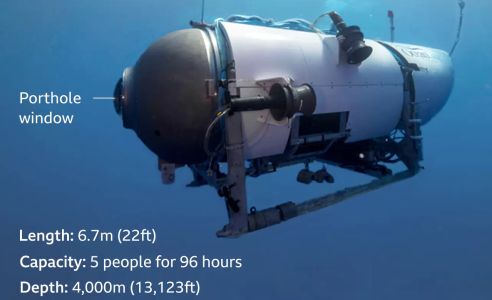
Titan submersible. Source: OceanGate Expeditions
The US Coast Guard is racing against time to locate and rescue a submersible with five people onboard that went missing on Sunday morning in the North Atlantic while attempting to dive on the wreck of the Titanic. The area being searched for the 22′ submersible, Titan, is larger than the state of Connecticut, in waters 2 nautical miles deep.
US Coast Guard officials said Tuesday afternoon that the five people inside the submersible were believed to have roughly 40 hours of breathable air left.
Speaking at a news conference in Boston, Capt. Jamie Frederick said that crews were “doing everything possible” as part of a “complex search effort.” But so far, he said, those efforts “have not yielded any results.”
The US Coast Guard has directed a massive search effort in coordination with other agencies since Sunday, including commercial vessels, the US Navy, US Air National Guard, the Canadian Coast Guard and Navy. Aircraft and surface vessels are looking for the submersible on the surface and underwater.
On Tuesday, the vessel Deep Energy, a 194-meter pipe-laying vessel with underwater capabilities, arrived on scene and rendezvoused with the Polar Prince, the vessel the submersible launched from, to commence a dive at the last known position of the sub and at the approximate position of the Titanic wreck, Capt. Frederick said at a news conference.
The tug and supply vessel Atlantic Merlin is also on its way.
The BBC reports that the submersible has seven safety systems to help it return to the surface.
- Triple weights: three lead pipes that can be dropped using hydraulics to gain buoyancy
- Roll weights: if the hydraulic systems fail those inside the sub can tilt the sub by moving to each side of it releasing weights held in place on each side by gravity
- Ballast bags: motors can be used to release bags full of metal shot hanging beneath the sub
- Fusible links: bonds that disintegrate after 16 hours in seawater to drop the ballast bags if the electrics and hydraulics fail
- Thrusters: to push it to the surface
- Sub’s legs: the pilot can jettison the sub’s legs as dead weight
- Airbag: the crew can inflate an airbag to provide buoyancy
The BBC also notes that If the Titan is on the seabed and can’t get back up under its own power, the options are very limited, according to submarine expert Prof Alistair Greig from University College London.
“While the submersible might still be intact, if it is deeper than more than 200m (656ft) there are very few vessels that can get that deep, and certainly not divers. The vehicles designed for navy submarine rescue certainly can’t get down to anywhere near the depth of the Titanic.”
According to OceanGate, the operator of the submersible, the Titan is one of only five manned submersibles in the world capable of reaching the Titanic, which sits at 3,800m (12,500ft) below the surface.

yikes… techcrunch.com /2023/06/20/a-whistleblower-raised-safety-concerns-about-oceangates-submersible-in-2018-then-he-was-fired/
6/20/2023
The director of marine operations at OceanGate, the company whose submersible went missing Sunday on an expedition to the Titanic in the North Atlantic, was fired after raising concerns about its first-of-a-kind carbon fiber hull and other systems before its maiden voyage, according to a filing in a 2018 lawsuit first reported by Insider and New Republic…Lochridge’s recommendation was that non-destructive testing of the Titan’s hull was necessary to ensure a “solid and safe product.” The filing states that Lochridge was told that such testing was impossible, and that OceanGate would instead rely on its much touted [sic] acoustic monitoring system…